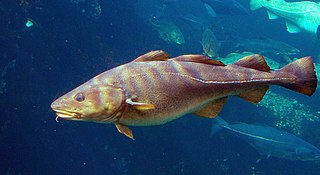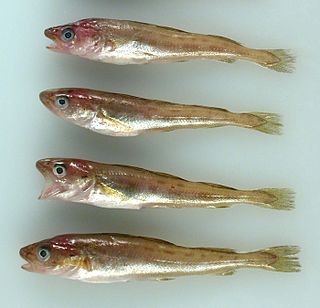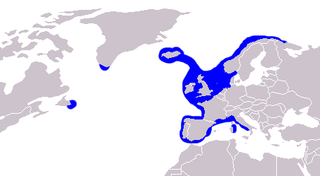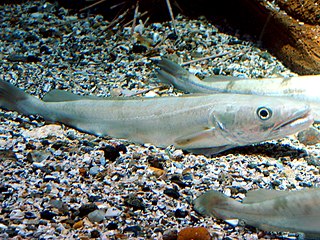
Cod is the common name for the demersal fish genus Gadus, belonging to the family Gadidae. Cod is also used as part of the common name for a number of other fish species, and one species that belongs to genus Gadus is commonly not called cod.

Gadiformes are an order of ray-finned fish, also called the Anacanthini, that includes the cod. Many major food fish are in this order. They are found in marine waters throughout the world and the vast majority of the species are found in temperate or colder regions. A few species may enter estuaries but only one, the burbot, is a freshwater fish.

The haddock is a saltwater ray-finned fish from the family Gadidae, the true cods. It is the only species in the monotypic genus Melanogrammus. It is found in the North Atlantic Ocean and associated seas, where it is an important species for fisheries, especially in northern Europe, where it is marketed fresh, frozen and smoked; smoked varieties include the Finnan haddie and the Arbroath smokie.

Boreogadus saida, known as the polar cod or as the Arctic cod, is a fish of the cod family Gadidae, related to the true cod. Another fish species for which both the common names Arctic cod and polar cod are used is Arctogadus glacialis.

Arctogadus glacialis, known also with ambiguous common names Arctic cod and polar cod, is an Arctic species of fish in the cod family Gadidae, related to the true cod. Arctogadus glacialis is found in icy water. They grow to about 30 cm long, and are favorite food of narwhals and other arctic whales.

The saffron cod(Eleginus gracilis) is a commercially harvested fish closely related to true cods. It is dark grey-green to brown, with spots on its sides and pale towards the belly. It may grow to 55 cm and weigh up to 1.3 kg.

Demersal fish, also known as groundfish, live and feed on or near the bottom of seas or lakes. They occupy the sea floors and lake beds, which usually consist of mud, sand, gravel or rocks. In coastal waters they are found on or near the continental shelf, and in deep waters they are found on or near the continental slope or along the continental rise. They are not generally found in the deepest waters, such as abyssal depths or on the abyssal plain, but they can be found around seamounts and islands. The word demersal comes from the Latin demergere, which means to sink.

The common ling, also known as the white ling or simply the ling, is a large member of the family Lotidae, a group of cod-like fishes. It resembles the related rocklings, but it is much larger and has a single barbel. This species is unrelated to the pink ling, Genypterus blacodes, from the Southern Hemisphere. The common ling is found in the northern Atlantic, mainly off Europe, and into the Mediterranean Basin. It is an important quarry species for fisheries, especially in the northeastern Atlantic, although some doubts exist as to the sustainability of the fisheries. As an edible species, it is eaten fresh, frozen, or dried, but also preserved in lye, while the roe is a delicacy in Spain.

The Pacific staghorn sculpin is a species of marine ray-finned fish belonging to the family Cottidae, the typical sculpins. This species is found in the eastern Pacific Ocean. It is the only species in the monospecific genus Lepidocottus.

The southern blue whiting is a codfish of the genus Micromesistius, found in the southern oceans with temperatures between 3 and 7 °C, at depths of 50 to 900 m. Its length is commonly between 30 and 60 cm, with a maximum length of 90 cm. Maximum weight is at least 1350 g.

Pollachius pollachius is a species of marine fish in the family Gadidae. FAO uses the English name pollack for this species, whereas in American English it is known as European pollock. Other vernacular names include lythe, and in the Isle of Man, calig.

The European flounder is a flatfish of European coastal waters from the White Sea in the north to the Mediterranean and the Black Sea in the south. It has been introduced into the United States and Canada accidentally through transport in ballast water. It is caught and used for human consumption.

Coastal fish, also called inshore fish or neritic fish, inhabit the sea between the shoreline and the edge of the continental shelf. Since the continental shelf is usually less than 200 metres (660 ft) deep, it follows that pelagic coastal fish are generally epipelagic fish, inhabiting the sunlit epipelagic zone. Coastal fish can be contrasted with oceanic fish or offshore fish, which inhabit the deep seas beyond the continental shelves.

Merluccius merluccius, the European hake, is a merluccid hake of the genus Merluccius. Other vernacular names include Cornish salmon and herring hake. It is a predatory species which was often netted alongside one of its favoured prey, the Atlantic herring, thus the latter common name. It is found in the eastern Atlantic from the Norway and Iceland south to Mauritania and into the Mediterranean Sea. It is an important species in European fisheries and is heavily exploited with some populations thought to be being fished unsustainably.

Trisopterus is a genus of small cods, family Gadidae. They are native to the northeastern Atlantic Ocean including the Mediterranean Sea.
The Panama hake, also known as the dwarf hake, is a merluccid hake found off the west coast of the Americas from Del Mar, California, to Ensenada de Tumaco, Colombia.

Trachyrincus scabrus, the roughsnout grenadier or Mediterranean longsnout grenadier, is a species of bathydemersal marine fish from the subfamily Trachyrincinae, part of the family Macrouridae. It is found in the eastern Atlantic Ocean and the Mediterranean.
Merluccius australis, the southern hake, is a species of fish from the family Merlucciidae, the true hakes. It is found in the southern Pacific and Atlantic Oceans with two disjunct populations, one around southern South America and the other in the waters around New Zealand.
Merluccius senegalensis, the Senegalese hake, is a species of fish from the family Merlucciidae, the true hakes. It is found in the sub tropical waters of the eastern Atlantic Ocean off the north western coast of Africa.

Gadella maraldi, the gadella or morid cod, is a species of fish in the family Moridae from the warmer waters of the north eastern Atlantic Ocean and the Mediterranean Sea.

















